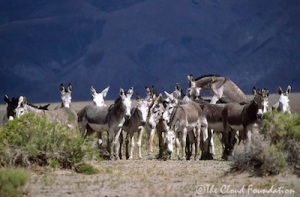Comments Needed for Cibola-Trigo Environmental Assessment
Dear Wild Horse & Burro Supporters;
The Bureau of Land Management (BLM) manages wild burro herds at disastrously low numbers throughout the West. One of the few viable burro herds lives in the immense Cibola-Trigo Herd Management Area (HMA) in southwestern Arizona along the Colorado River—a 600,000 acre area.
Yet, even here, burros are in danger. The inept Sun J roundup crew is set to swoop into their peaceful desert home in early April, the height of the foaling time for burros.* Pregnant jennies are in danger of spontaneous abortion and small foals can be permanently damaged or killed.
350 burros will lose their freedom—roughly half the herd.
Even worse, the BLM plan calls for capturing and gelding 50 males and releasing them back to the range. Returning geldings into a reproducing wild herd would set a deadly precedent. There are no studies that measure the potential damage to a society of wild burros (or horses). From a behavioral standpoint, geldings have no role in either a wild horse or wild burro herd.
BLM rejects the use of dartable infertility drugs saying they have not been tested on wild burros, yet they opt for surgically sterilizing jack burros. In fact, PZP was successfully tested on the U.S. Virgin Islands wild burro herd in 1996.
BLM states in their EA “at no time should cryptorchid jacks be released back into an HMA.” The EA continues saying that they will be “shipped to a BLM facility for appropriate surgery or euthanasia (emphasis added) if it is determined they cannot be fully castrated.” If the jack is a full cryptrorchid (two undescended testicles), it is likely sterile, yet will display all the natural behaviors of an intact male. By allowing these jacks to remain on the range, BLM could avail themselves of a natural form of population control.
To justify removing half the burro herd, BLM cites a high adoption demand for burros. (If this reasoning holds true, then BLM should immediately cease the removal of any more wild horses from their homes on the range!)
Below are suggested points to make in your letters. Please use your own polite words.
Comments must be submitted by Tuesday, February 28th, no later than the close of business at 4:30 PM Mountain Time. If you feel like a little light bedtime reading, you can read the EA here.
Comments can be submitted via mail to:
John MacDonald, Field Manager
BLM Yuma Field Office
2555 E. Gila Ridge Rd
Yuma, AZ 85365
Or via email at: BLM_AZ_YM_WHB@blm.gov – with “Cibola-Trigo EA Comments” in the subject line.Dear Sir;
- Select the No Action Alternative
- Conduct an accurate, current census using the most up-to-date technology
- Consider other methods of population control (PZP)
- Return cryptorchid jacks to the range as natural population control
- Do not kill healthy burros for any reason
- Consider capture methods other than a helicopter roundup (bait and water trapping)
- Do not run small foals and pregnant jennies with a helicopter
- Do not geld the jacks and do not release gelded jacks into the herd area
- Do not threaten the social dynamics of a wild burro society by returning geldings to the range
- Prepare an Environmental Impact Statement before taking the drastic sterilization actions outlined in this EA
- Do not skew the sex ratio
- Do not remove any elder animals
- Do not use our tax dollars to conduct this costly roundup
[Your name]
*Burros are polyestrous and foal throughout the year in the American southwest, but the documented height of the foaling period is March and April according to international expert and CITES representative for asses, Patricia Moehlman.
< /div>











No comments:
Post a Comment